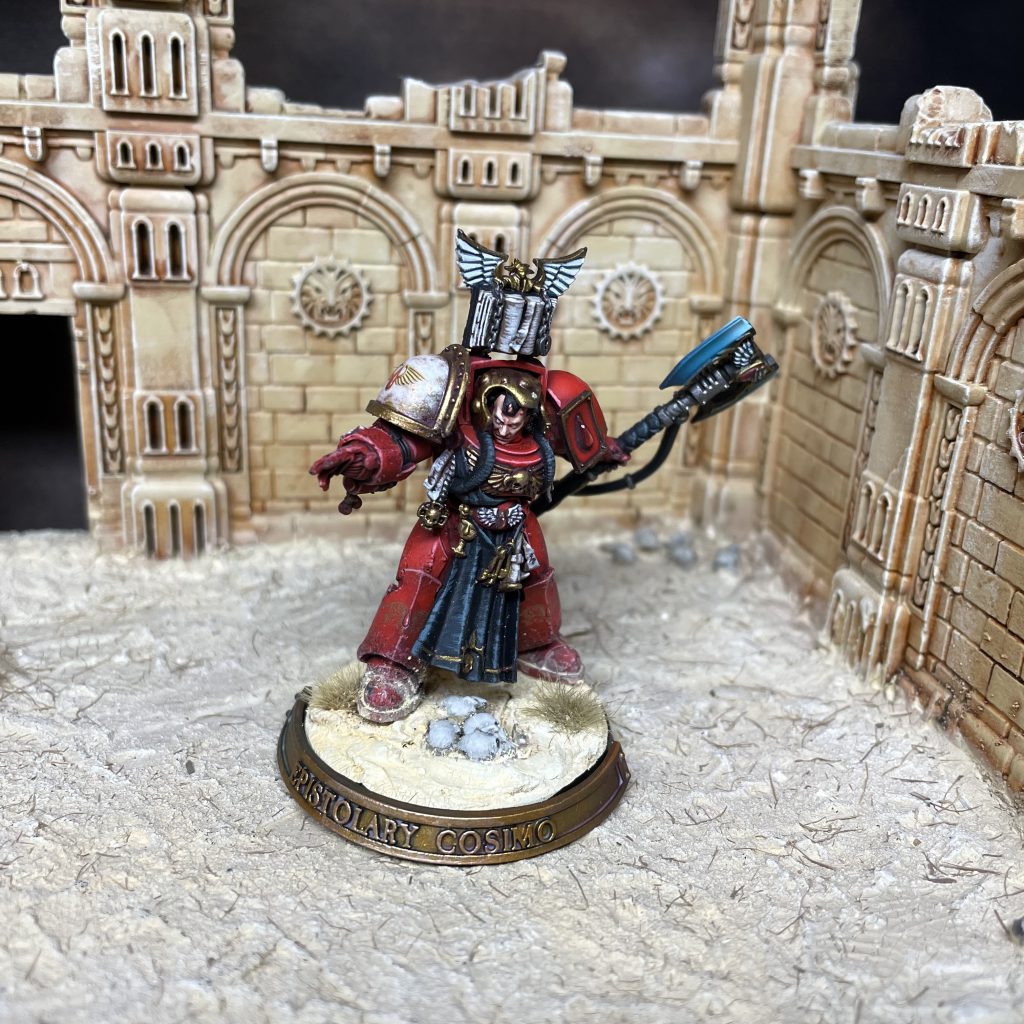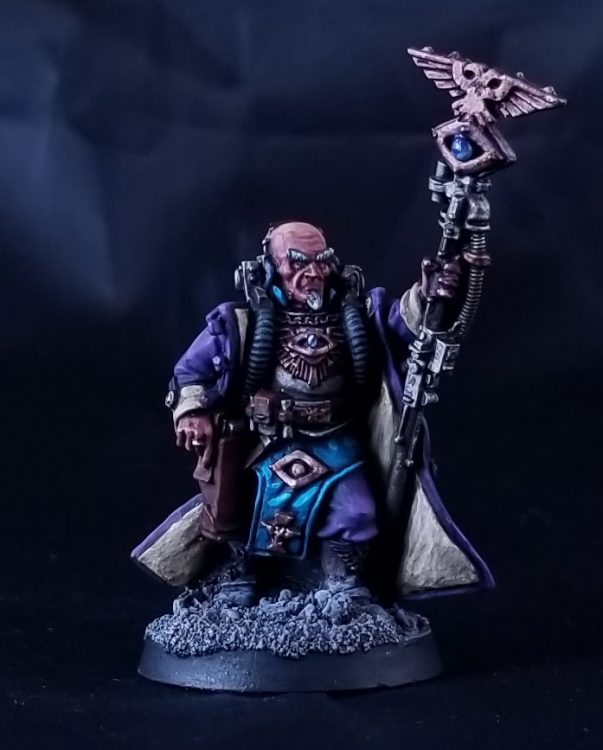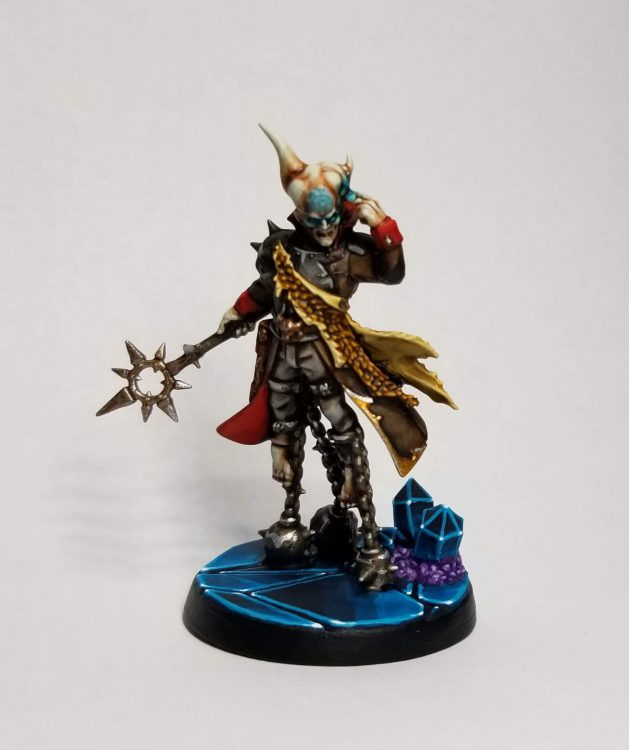Welcome to Horus Heresy Tactica, our series that provides a deep dive in a specific mechanic, interaction or aspect of play in Warhammer: the Horus Heresy.
Psychic powers have been a part of Warhammer games for decades, and Warhammer: the Horus Heresy has a novel approach that is similar to several previous incarnations but not identical to any of them.
Each Psychic Discipline provides a Psychic Power and a Psychic Weapon. The Psychic Power is an ability used in the place of another kind of action, or used as a special supplementary action at a particular point in play. A Psychic Weapon is just that – a weapon that you can use in combat but that requires a Psychic check to make use of.
There are six core psychic disciplines that we’ll be looking at today, along with a psychic weapon usable by all those who choose a Core Psychic Discipline, Aetheric Lighting. Not that this is all those who choose a Core Psychic Discipline, so if you get one from another source you do not get access to Aetheric Lightning.

Psychic Powers and Perils of the Warp
Psychic Weapons are simple to use – you use them in the place of another weapon. Powers have a little more complexity and the most important thing to note is that a large number of them replace a Shooting Attack, but do not specify that you have to use them in the Shooting Phase. This means that you can absolutely use them in a Return Fire, Overwatch or even Interceptor reaction. In addition, the “Psyker” is the one who replaces their attack, so if they’re embedded in unit then the rest of the unit can still shoot their guns.
Another thing to consider is when a Psyker suffers Perils of the Warp (which can happen when you fail a Psychic test) the unit suffers d3 wounds that can only be saved using Invulnerable Saves (and you cannot use Damage Mitigation). But that means that these wounds can be assigned to models as you like, so a Librarian in a unit of Cataphractii Terminators, for example, can assign these wounds to the terminators who can use their 4+ invulnerable save to protect themselves. This makes librarians much more able to survive Perils of the Warp.
Aetheric Lightning
If you choose a Core Psychic Discipline you also get access to the Aetheric Lighting Psychic Weapon. This is a pretty underwhelming weapon, but it doesn’t require a psychic check which marks it out from the other Psychic Weapons – you can merely choose to make one to bump its 4 shots from S3 to S6. It’s still only AP4 and it’s short range, so I can’t see people making much use of this, but it’s perfectly acceptable if you have nothing better to use.
Biomancy
Biomancy is about augmenting biological energy and provides the Biomantic Augmentation psychic power and the Biomancer’s Rage psychic weapon. This is a combat librarian build, intended to get up close and personal and run with some rough lads who can do some serious harm.
Biomantic Augmenation is a power used instead of making a Shooting Attack (so can be used in Reactions), and it selects a friendly unit within 6″ to increase their Strength by +1 or, if you make and pass a check, also increases their Toughness by the same. They’re increased by +1 for the duration of the current player turn, so you need to cast this in the turn this unit wants the bonus, which is mostly going to be in assault (either receiving one or launching one). Strength +1 is great, but more useful for tweaking those wound rolls than getting to Instant Death because modifiers like this come after doubling, not before. That said it pushes a power fist on a normal marine to S9 which is enough to seriously crack armour and wound a Contemptor on a 2. The real prize is on things like Assault Marines though, pushing them to wound a little easier against normal marine targets. Blood Angels Assault Marines can become absolute horrors, taking on even Dreadnoughts, with this combination. The Toughness bonus is obviously great, and importantly can bring you out of Instant Death range in a lot of cases, which is fantastic on Veterans or Terminators.
Biomancer’s Rage is really an anti-armour melee weapon, looking to crack open enemy vehicles in an assault. You can make your normal number of attacks (so you can easily get to 5 on the charge) and S10 with Rending (4+) is enough to crack open Land Raiders relatively easily. Brutal, but of course you have to get them there.

Divination
Divination is about seeing the future (albeit not by much) and grants the Divinatory Aegis psychic power and the Diviner’s Dart psychic weapon. This is a sniper and special forces discipline, best used with units with strong shooting that can fight at short-medium range, but that don’t already benefit from precision strikes (I like Tactical Support Squads for this).
Divinatory Aegis is another power used instead of a Shooting Attack but is a little less useful in a reaction, though certainly not useless. It grants Precision Strikes (6+) and Precision Shots (6+), that improve to 5+ with a psychic check, and last for the duration of the current player turn. This can, for example, let you pummel melta or plasma straight into a character in a unit, or take out models with specific equipment with ease.
Diviner’s Dart is a psychic weapon that has the Sniper and Guided Fire rules, plus ap2, albeit with a single shot. But this is absolutely great for shooting out an apothecary through walls or taking out a sergeant or something similar, but probably isn’t worth doing for things like taking on an Independent Character (use the Aegis for that).
Pyromancy
Pyromancy is about BURNING IT ALL, BURRRRRNNNNNN and grants the Pyromantic Combustion psychic power and Pyromantic Desolation psychic weapon. Look, I’ll be honest, this is not great compared to the other options here. If you really love fire, then go for it, but it’s probably not the optimum pick.
Pyromantic Combustion once more steps into the place of a Shooting Attack and lets you place a Large Blast that scatters a short distance and then stays in place until the beginning of your next Shooting phase. The area is now difficult terrain and anything that touches it or gets touched by it takes a s6 ap4 hit. That’s not terrible but it’s also not great, and a single blast marker isn’t really enough to usefully use this to block off enemy advances. Luckily if you pass a check you can instead throw down three blast markers, and that’s a bit more interesting. If you want to slow an advance, maybe get some lucky hits through, or disrupt the advance of bikers or vehicles a little, this isn’t terrible, but it’s relatively niche.
Pyromantic Desolation is a real disappointment. The ap3 isn’t terrible, but it’s unwieldy which is rough. The special rule also isn’t great, because the blast marker goes around the pysker, you’re likely to hit your own models if you’re not careful, and any wounds don’t add to combat resolution (why not?). If they did, it would be worth considering, but without it this is one of the weaker psychic weapons.
Telekinesis
If you want to move stuff with your mind, Telekinesis is for you. It grants the Telekine Dome psychic power and the Telekine’s Focus psychic weapon. It’s best used in a support role, protecting heavy support units that might be vulnerable to enemy fire.
Telekine Dome is more of a support power, best used to stand with a group of heavily armed but relatively vulnerable troops. The little dome of 8″ is useless if someone is within that dome, so you need the units affected to be ranged attackers. You also, really, need the psychic check to go off – a 6+ Invulnerable Save isn’t much to shout about but a 4+ really is, especially on things like heavy support squads. Put this guy with a little bodyguard with a couple of lascannon heavy support squads and he will do a stellar job keeping them alive.
Telekine’s Focus is probably a little short range for it to be useful in combination with Telekine Dome, and of course using it disrupts the power, so you’re not likely to get that much use from it. If you fail the check on that power though then you may want to shift to using this as the dome has come down anyway, and it’s fine if not great – S8 with sunder is ok for attacking light vehicles, and I guess it being a 3″ blast means you might hit a couple of Predators in a Squadron if you’re really lucky, but ap4 makes it less than great against infantry so it’s not in an amazing place.

Telepathy
If you want to move the minds of others with your own, then Telepathy is king. It’s an emerging favourite in the new edition, and it’s easy to see why with the Telepathic Fugue psychic power and the Telepathic Hallucinations psychic weapon. This is really incredibly flexible, and it’s hard to not recommend – if in doubt, if you don’t have a clear role for your psyker, then this is a great choice.
Telepathic Fugue is used at the start of any Phase once a turn and basically just hits a switch on an enemy unit within 24″ and line of sight and makes that unit unable to use Reactions for the Phase. This is staggeringly good. Want to stop Overwatch as you charge? This is your power. You want to hit something nasty hard and not get Return Fire? Here you go. Really need an enemy unit to stay in place as you move near it? Fantastic stuff. Hard to recommend this power harder really – canny use can make this have a devastating effect on the battlefield.
Hallucinations is somehow though the real star of the discipline. This is an Assault 6 weapon with 36″ range which does no damage but each hit adds 1 to the Pinning test that results when you score any. Given the BS 5 of a consul, this means 5 hits on average, and because this adds to the roll rather than modifying leadership stubborn and other special rules don’t help. This is absolutely ruinous, and more or less makes certain of pinning an enemy unit. Use it as much as possible on anything you can pin – in reactions, in your shooting phase, whenever. It is probably the single best psychic power in the game. Remember if you use this in Overwatch you can even prevent a charge.
Thaumaturgy
The power to shape raw warp energy, Thaumaturgy is a strange discipline that’s much more niche than most of the others. It grants Thaumaturgic Succour as a psychic power and Thaumaturge’s Cleansing as a psychic weapon. It’s difficult to recommend this outside of very specific circumstances, but in those specific circumstances it’s fantastic.
Thaumaturgic Succour basically, instead of a Shooting Attack, lets every model in a unit within 12″ roll a die and get a wound back on a 5+. This is pretty niche as wound allocation generally means stuff is gonna die not be left on a number of wounds, so you’re probably healing at most one or two wounds. It’s ok on Independent Characters but that’s a lot of points to dump in a model to heal a wound off an Independent Character. It really shines when it’s used with units where all the models are characters, because that lets them spread wounds around much more evenly, and gives a good chance of recovering a few of them.
Thaumaturge’s Cleansing is basically a flamer but with the Santic special rule that’s fantastic against Daemons (wounding on a 2+ and forcing successful Invulnerable Saves to be rerolled) but pretty trash against everything else. If you live in a world (in the future for now) where Ruinstorm Daemons stride mighty and unbroken across every table and you need an absolutely awesome daemon-killing-machine in your back pocket because it comes up that much, then this is great. Until then, not so much.
In Conclusion
The Core Psychic Disciplines offer a huge range of different benefits, and all of them have some kind of place, but there are certainly some stand out choices. Choosing your discipline to match your overall battle plan is essential, and you want to be sure what every psyker you bring is doing and providing your troops.


